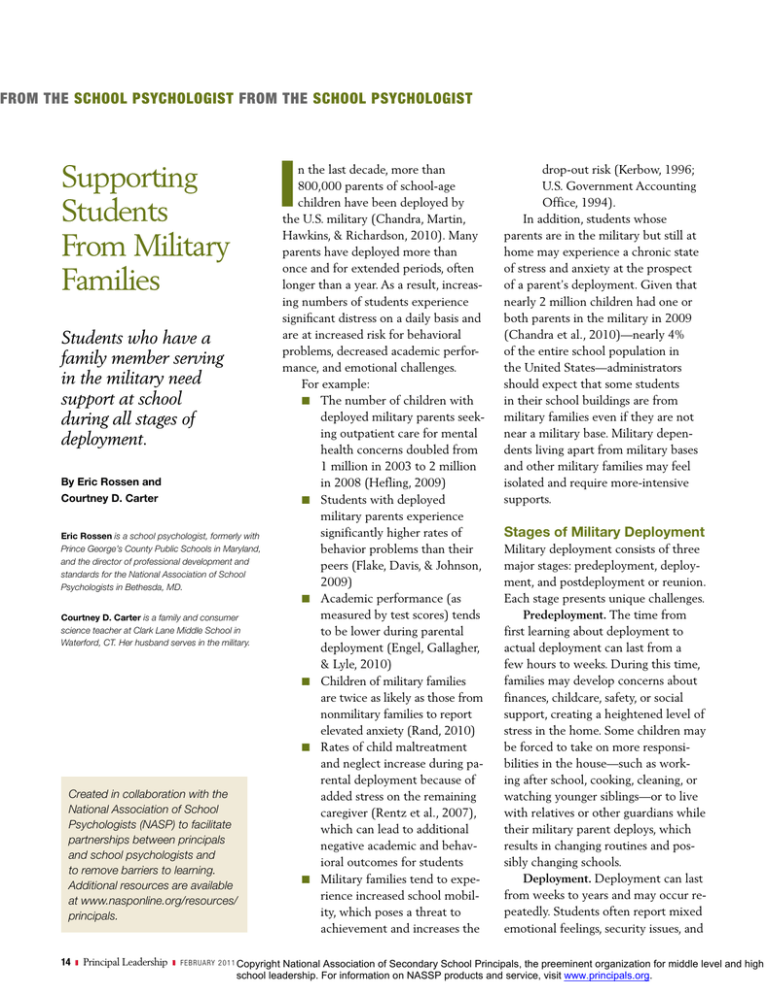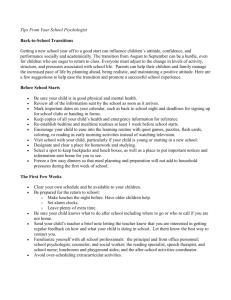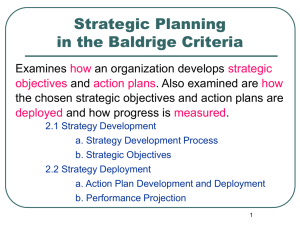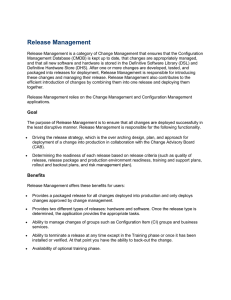i Supporting from the
advertisement

from the school psychologist from the school psychologist I Supporting Students From Military Families Students who have a family member serving in the military need support at school during all stages of deployment. By Eric Rossen and Courtney D. Carter Eric Rossen is a school psychologist, formerly with Prince George’s County Public Schools in Maryland, and the director of professional development and standards for the National Association of School Psychologists in Bethesda, MD. Courtney D. Carter is a family and consumer science teacher at Clark Lane Middle School in Waterford, CT. Her husband serves in the military. Created in collaboration with the National Association of School Psychologists (NASP) to facilitate partnerships between principals and school psychologists and to remove barriers to learning. Additional resources are available at www.nasponline.org/resources/ principals. 14 z Principal Leadership z febr uary 2011 Copyright n the last decade, more than 800,000 parents of school-age children have been deployed by the U.S. military (Chandra, Martin, Hawkins, & Richardson, 2010). Many parents have deployed more than once and for extended periods, often longer than a year. As a result, increasing numbers of students experience significant distress on a daily basis and are at increased risk for behavioral problems, decreased academic performance, and emotional challenges. For example: n The number of children with deployed military parents seeking outpatient care for mental health concerns doubled from 1 million in 2003 to 2 million in 2008 (Hefling, 2009) n Students with deployed military parents experience significantly higher rates of behavior problems than their peers (Flake, Davis, & Johnson, 2009) n Academic performance (as measured by test scores) tends to be lower during parental deployment (Engel, Gallagher, & Lyle, 2010) n Children of military families are twice as likely as those from nonmilitary families to report elevated anxiety (Rand, 2010) n Rates of child maltreatment and neglect increase during parental deployment because of added stress on the remaining caregiver (Rentz et al., 2007), which can lead to additional negative academic and behavioral outcomes for students n Military families tend to experience increased school mobility, which poses a threat to achievement and increases the drop-out risk (Kerbow, 1996; U.S. Government Accounting Office, 1994). In addition, students whose parents are in the military but still at home may experience a chronic state of stress and anxiety at the prospect of a parent’s deployment. Given that nearly 2 million children had one or both parents in the military in 2009 (Chandra et al., 2010)—nearly 4% of the entire school population in the United States—administrators should expect that some students in their school buildings are from military families even if they are not near a military base. Military dependents living apart from military bases and other military families may feel isolated and require more-intensive supports. Stages of Military Deployment Military deployment consists of three major stages: predeployment, deployment, and postdeployment or reunion. Each stage presents unique challenges. Predeployment. The time from first learning about deployment to actual deployment can last from a few hours to weeks. During this time, families may develop concerns about finances, childcare, safety, or social support, creating a heightened level of stress in the home. Some children may be forced to take on more responsibilities in the house—such as working after school, cooking, cleaning, or watching younger siblings—or to live with relatives or other guardians while their military parent deploys, which results in changing routines and possibly changing schools. Deployment. Deployment can last from weeks to years and may occur repeatedly. Students often report mixed emotional feelings, security issues, and National Association of Secondary School Principals, the preeminent organization for middle level and high school leadership. For information on NASSP products and service, visit www.principals.org. difficulty sleeping, particularly during the first month of deployment (Fitzsimons & Krause-Parello, 2009). Once a new normal is established, those symptoms often improve, although students often continue to experience feelings of isolation, neglect, and fear for their parents’ safety because of irregular communication and frequent exposure to the media’s war coverage. Research suggests that longer deployments lead to increased need for psychiatric treatment for the at-home caregiver (Mansfield et al., 2010). Given that the mental health of the remaining caregiver strongly affects adjustment during deployment, the home environment can become potentially harmful, leaving the school as a safe haven for many students. Postdeployment (reunion). Students may experience a spectrum of emotions when a deployed parent returns, even concern about whether the returning parent will remember or love them. Further, upon reintegration in the household, the family will once again have to adjust to new routines and family dynamics. Postdeployment has become particularly problematic given the increase in the number of soldiers returning from military duty with post-traumatic stress disorder (PTSD) or brain injury. In fact, as of May 2010, the Defense and Veterans Brain Injury Center reported 178,876 total cases of traumatic brain injury (TBI) among returning military personnel since 2000. The debilitating effects of these conditions make it even more difficult for parents to resume their caregiver duties after they have returned. Parents with PTSD may spend less time with their children, develop short tempers, behave differently, be reluctant to travel with their family, and have difficulties reconnecting with their children. Further, suicide rates have increased 71% from 2001 to 2009 among active military personnel (American Psychological Association, 2010), which increases the risk of suicide among their children. Recommendations for Schools Talk about it. Administrators should encourage staff members to discuss deployment with students, including details about where the parents are going and the roles they serve within the military. Students who talk about deployment with adults adjust better than those who don’t. Many military students who transition into new schools may not share their experiences or circumstances, so a “lunch bunch” program with an administrator, the school psychologist, or another support staff member is one way to invite students to open up. Maintain frequent communication with the at-home caregiver. By supporting parents, you are also supporting your students, so make everyone aware of the school services available to military families. On your parent contact forms, include a section for parents to indicate their preferred forms of communication and a field for parent employment to help screen for students from military families. Some deployed parents may also be able to communicate by e-mail. Consider being flexible with parent meetings to include one or both parents by phone or even webcam. Accommodate attendance. Students will likely miss some school during the various deployment stages, especially homecoming. Further, some students may have altered living situations, causing them to arrive late By supporting parents, you are also supporting your students, so make everyone aware of the school services available to military families. f e b r u a ry 2 0 1 1 z Principal Leadership z 15 from the school psychologist from the school psychologist Frequently Asked Questions How do I answer difficult questions from students about the war and their parents? Answer questions honestly but simply. The level of detail should be determined by the parents. If you have not spoken to the at-home caregiver about what he or she wants shared with the student, tell the student that you will try to find out, then call the parent to discuss. Should I limit coverage of the war in classes that discuss current events? Incorporating world events may be an integral part of the curriculum, but staff members should be careful not to overwhelm students with extensive war or military media coverage. Focus on the goals of military involvement, rather than the danger or potential for injury. Personal opinions regarding the military and war should not be discussed. Will emergency drills be a problem for students with deployed parents? Some students with deployed parents may have an aversive reaction to a drill, such as a fear or anxiety response, or come to believe that school is not a safe place, even if they have done similar drills for years. Reassure students that the school is safe, and give them a heads-up about practice drills. 16 z Principal Leadership z febr uary 2011 more frequently and have less time to complete assignments. Reasonable accommodations (following a discussion with caregivers) can go a long way, but holding students accountable for their work and maintaining consistent expectations remains important. The school psychologist or a counselor can help develop strategies that will enable students to keep up with their work. Provide appropriate class placement. Because of frequent moves, students in military families may have gaps in their education. Meet with each student, his or her family, teachers, a school counselor, and the school psychologist during transitions to help assess the knowledge that the student has acquired to ensure proper ­placement. Use the experiences of military students. Military students have unique skills and background experiences, perhaps from living in other countries, that can help enrich the school. Drawing those experiences out can help students feel valued and connected to the school. Consider classroom or schoolwide initiatives. Writing letters or e-mails can be therapeutic for students with deployed parents. Create a schoolwide activity by setting up military pen pals for all of your students. Visit www .operationmilitarypride.org, www .emailourmilitary.com, or www .­militarycity.com/letters for assistance. The National Association of School Psychologists (NASP) has also recently developed a program titled “Gratitude Works” that encourages students to write letters of gratitude to individuals who have made a difference in their lives or the lives of others. Free materials for this program are available at www.nasponline.org. This program sends positive messages to the troops, the students, and their families. It also reinforces the benefits of expressing gratitude, which is associated with well-being, resilience, and academic achievement. Sending care packages to military members—such as a deployed parent or an adopted soldier—could be a class or schoolwide project. For more information on sending care packages, please visit www.operationmilitarypride.org/ packages.html. Maintain routines and structure. When parents return from deployment, they may experience physical and emotional symptoms, particularly if they sustained an injury or witnessed violence. Expect an adjustment period, but encourage your staff members to maintain consistency, predictability, and structure in the school environment to provide a sense of stability. Consider offering advance notice to these students of schedule changes, such as testing schedules, planned fire drills, and early dismissal days. Help students create new ways to reconnect and understand disabilities. School staff members can devise ways to help students in specific situations and also help all students better understand disabilities. In the case of a parent who experiences a debilitating physical injury (e.g., ­losing a limb), the student might work with Making a Referral When should teachers or administrators make a referral to a mental health professional? If distress signs and symptoms persist over several weeks, it would be best to consult with or refer the student to the school psychologist or a social worker. The Educational Opportunities Directorate of the U.S. Department of Defense (n.d.) identified the following as warning signs if they persist for more than six to eight weeks: Groups at Increased Risk n Young children n Males n Students with preexisting health or mental health problems 1.Difficulty resuming normal classroom assignments and activities n Families with multiple 2. High levels of emotional response, such as frequent crying or sadness n Single-parent families 3. Depression and withdrawal deployments n Dual–military parent families 4. Inattention and distractibility 5. Expressions of violent or depressed feelings 6. Self-injury 7. Significant weight gain or loss 8. Reduced self-care Source: U.S. Department of Defense, Educational Opportunities Directorate. (n.d.). Educator’s guide to the military child during deployment. Retrieved from www2.ed.gov/about/offices/list/os/ homefront/homefront.pdf 9. Substance abuse. a staff member to create a list of activities that the student can still do with his or her parent. For the whole school, students could attempt daily activities with a blindfold on or with one arm tied behind their backs and then describe the experience. Other activities include asking one class at a time to dress in an unusual way to experience the feeling of standing out. Such activities might help create more tolerance for other students with disabilities in the school building as well. Ask special education staff members and the school psychologist to help plan those activities because of their knowledge of disabilities. Encourage active participation. Encouraging students to volunteer at school or in the community helps them feel connected and in control. Importantly, students should also be reminded to not feel guilty for having fun and encouraged to continue such activities as after-school sports or other cocurricular activities. A sudden decline in participation in such activities can be forewarning of mental health concerns. Train the staff. Offer professional development opportunities on this topic to raise staff members’ awareness and competence in s­ upporting military students. Information on Encouraging students to volunteer at school or in the community helps them feel connected and in control. f e b r u a ry 2 0 1 1 z Principal Leadership z 17 from the school psychologist from the school psychologist Online Resources www.dodea.edu/instruction/ crisis www.militaryimpacted schoolsassociation.org www.nasponline.org www.ourmilitarykids.org www.nctsnet.org training opportunities (live and online) can be found at www.military child.org, www.deploymentpsych.org/ training, and www.jhsph.edu/mci. In addition, family support service centers at local military bases can provide additional information, which can be placed on display in the main office or disseminated to the staff. Reach out to neighboring administrators. Reach out to administrators in neighboring districts to create a network and develop a support group that can communicate over e-mail, engage in joint projects, start a club, or help educate other students. Document, document, document. School staff members should document any changes of behavior or activity level to determine any developing patterns. This should include a regularly updated log of parent communication, staff communication and referrals, behaviors, responses, interventions, and outcomes. 18 z Principal Leadership z febr uary 2011 Conclusion Students from military families, particularly those with a parent deployed to a war zone, are at increased risk for numerous negative outcomes as well as home instability. Schools that support military students can improve their availability for learning and overall academic performance. Providing structure, consistency, sensitivity, and dependability for military children while acknowledging their many attributes can help improve student well-being and, consequently, student learning. PL References n American Psychological Association. (2010, September). Military suicides continue to climb. Monitor on Psychology, 4(8), 11. n Chandra, A., Martin, L. T., Hawkins, S. A., & Richardson, A. (2010). The impact of parental deployment on child social and emotional functioning: Perspectives of school staff. Journal of Adolescent Health, 46(3), 218–223. n Defense and Veterans Brain Injury Center. (2010). Department of Defense numbers for traumatic brain injury. Retrieved from www.dvbic.org/TBI-Numbers.aspx n Engel, R. C., Gallagher, L. B., & Lyle, D. S. (2010). Military deployment and children’s academic achievement: Evidence from Department of Defense Education Activity schools. Economics of Education Review, 29, 73–82. n Fitzsimons, V. M., & Krause-Parello, C. A. (2009). Military children when parents are deployed overseas. Journal of School Nursing, 25(1), 40–47. n Flake, E., Davis, B. E., & Johnson, P. L. (2009). The psychosocial effects of deployment on military children. Journal of Developmental & Behavioral Pediatrics, 30(4), 271–278. n Hefling, K. (2009, July 7). More military children seeking mental care. The Marine Corps Times. Retrieved from www .marinecorpstimes.com/news/2009/07/ ap_children_mental_health_070709/ n Kerbow, D. (1996). Patterns of urban student mobility and local school reform. Journal of Education for Students Placed At Risk, 1, 147–169. n Mansfield, A. J., Kaufman, J. S., Marshall, S. W., Gaynes, B. N., Morrissey, J. P., Engel, C. C. (2010, January). Deployment and the use of mental health services among U.S. Army wives. New England Journal of Medicine, 362(2), 101–109. n Rand. (2010). Viewed through a different lens: The effects of deployment on military children. Retrieved from www.rand.org/ congress/newsletters/child/2010/04/ n Rentz, E. D., Marshall, S. W., Loomis, D., Casteel, C., Martin, S. L., & Gibbs, D. A. (2007). Effect of deployment on the occurrence of child maltreatment in military and nonmilitary families. American Journal of Epidemiology, 165(10), 1199–1206. n U.S. Government Accounting Office. (1994). Elementary school children: Many change schools frequently, harming their education (GAO/HEHS Publication No. 94-45). Washington, DC: Author. Editor’s note: “Fostering Gratitude” by David N. Miller, an earlier column from NASP and NASSP, is available at www.principals.org/content .aspx?topic=59099.






